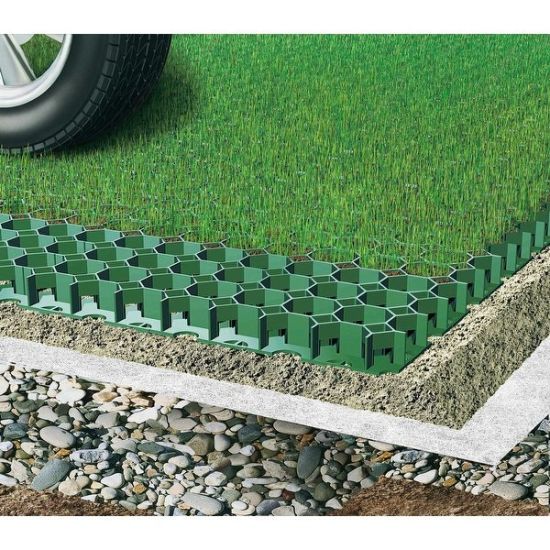In an era where sustainability and environmental conservation are paramount, innovative solutions that support green living while meeting practical needs are increasingly valuable. The grass grid system represents one such innovation, merging functionality with eco-friendliness to revolutionize how we approach landscaping and surface stabilization. This comprehensive article delves into the essence of grass grids, exploring their benefits, applications, and the transformative impact they have on creating sustainable, visually appealing outdoor spaces.
Understanding Grass Grid Systems
Grass grids, also known as grass pavers, are an interlocking system of grid-like structures that allow grass to grow through them while providing a stable base that can support foot and vehicle traffic. Made from permeable materials like plastic or concrete, these grids are designed to reinforce the ground and promote healthy grass growth, creating a natural yet durable surface.
The Multifaceted Benefits of Grass Grids
1. Enhanced Drainage: Grass grids promote better water absorption into the soil, reducing runoff and preventing erosion. This natural drainage system mitigates the risk of flooding and water pooling, contributing to a healthier local ecosystem.
2. Eco-Friendly: By allowing grass to grow within a stabilized structure, grass grids maintain green spaces, reduce heat island effects in urban areas, and support biodiversity. They are often made from recycled materials, further minimizing their environmental footprint.
3. Durability and Low Maintenance: Grass grids create surfaces that are both durable and low maintenance. They withstand wear and tear from foot traffic, vehicles, and weather conditions, requiring minimal upkeep compared to traditional paving methods.
4. Aesthetic Appeal: Grass grids blend the beauty of natural grass with the functionality of paved surfaces, enhancing the visual appeal of gardens, driveways, and public spaces without sacrificing greenery.
5. Versatility: Suitable for a wide range of applications, from residential lawns to parking areas and emergency access routes, grass grids offer a flexible solution that can be adapted to various needs and environments.
Applications and Implementations
Grass grids are incredibly versatile, finding applications in numerous settings:
- Residential Driveways and Parking: They provide a green alternative to concrete or asphalt, creating permeable, eco-friendly driveways that support vehicle weight without compromising the lawn’s health.
- Garden Pathways: Grass grids can be used to create stable, aesthetically pleasing pathways that blend seamlessly with the garden landscape.
- Emergency and Utility Access: Their durability makes them suitable for emergency and utility vehicle access routes, ensuring stability and accessibility without detracting from the natural environment.
- Commercial Landscaping: Businesses and municipalities can utilize grass grids to enhance the sustainability and appearance of parking lots, parks, and other public spaces.
Choosing the Right Grass Grid System
When selecting a grass grid system, consider the following factors to ensure optimal performance and sustainability:
- Material: Opt for grids made from high-quality, durable, and preferably recycled materials that can withstand the intended use and environmental conditions.
- Load Capacity: Ensure the grid system can support the weight and type of traffic it will encounter, whether pedestrian, vehicular, or heavy-duty service vehicles.
- Permeability: Choose grids that offer high permeability to support effective water drainage and prevent runoff.
- Installation Ease: Consider the ease of installation, including the need for professional assistance and the compatibility of the grid system with the existing landscape.
Installation and Maintenance
Installing grass grids involves preparing the ground, laying the grids, filling them with soil, and seeding grass. While the process is straightforward, proper installation is crucial to ensure the longevity and effectiveness of the system. Once installed, maintenance typically includes regular watering, mowing, and occasional aeration to promote healthy grass growth and maintain the system’s permeability.
The Impact of Grass Grids on Sustainable Development
Grass grids represent a tangible step toward more sustainable development practices, offering a solution that harmonizes human needs with environmental preservation. By promoting natural drainage, reducing heat islands, and preserving green spaces, grass grids contribute to the resilience and sustainability of urban and suburban landscapes. As awareness and adoption of grass grids grow, their potential to shape greener, more livable communities becomes increasingly evident.
Conclusion
Grass grids are more than just an innovative landscaping tool; they are a testament to the possibilities that arise when environmental consciousness meets practical application. Offering a blend of durability, aesthetics, and sustainability, grass grids pave the way for a future where green spaces and human infrastructure coexist harmoniously. Whether for residential use, commercial landscaping, or public utilities, grass grids offer a versatile, eco-friendly solution that champions the health of our planet while catering to our diverse needs.
